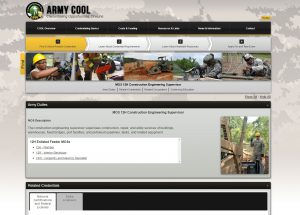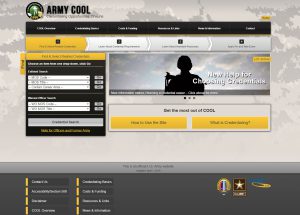Project Description
Since the project’s inception, SOLID
- Utilizes extensive knowledge of military and civilian occupational classification structures to crosswalk Army ratings, jobs, and designators to civilian occupations.
- Reviews Army course enabling and terminal objectives and assess applicability of Army training to civilian occupational standards and civilian credentials.
- Determines applicability of civilian credentialing requirements to military training and experience.
- Conducts comprehensive gap analyses comparing Army training to civilian credentialing requirements.
- Designs, develops, maintains, and constantly improves the COOL database and web site functionality and design.
- Coordinates areas of overlap between Army and Navy COOL to share relevant information and realize program efficiencies.
Planning
Project History
As part of the U.S. Army’s efforts to improve civilian credentialing opportunities for Soldiers, the Army Education Division, Army Human Resources, established the GI to Jobs initiative in August 2000. A main component of this initiative was the development of an Internet-based web site entitled Credentialing Opportunities On-Line (COOL). The COOL web site was designed to provide enlisted Soldiers with information on how to fulfill the requirements of civilian certifications related to their military occupational specialties (MOS), Additional Skill Identifiers (ASI) and Special Qualification Identifiers (SQI). The COOL web site was expanded in 2007 to include similar information for Warrant Officer MOSs.
Central to the GI to Jobs initiative and to Army COOL are comparability analyses that compare military education and training to civilian licensing and certification requirements. These analyses are intended to provide Soldiers with information on whether or not there are gaps between their military training and the civilian credentialing requirements. If there are gaps, Army COOL provides critical information on programmatic and financial resources available to Soldiers to fill the gaps. Data supporting these analyses are stored in a database, and the results of the analyses along with general information on credentialing are posted on the Army COOL Web site.
Research and Analysis
Primary Duties
SOLID supports all facets of the Army COOL initiative, including:
- Utilize extensive knowledge of military and civilian occupational classification structures to crosswalk Army military occupational specialties to civilian occupations.
- Review Army programs of instruction (POIs) and assess applicability of Army training to civilian occupational standards and civilian credentials.
- Determine applicability of civilian credentialing requirements to military training and experience.
- Conduct required certification gap analysis of enlisted and Warrant Officer military occupational specialties and of enlisted additional skill identifiers and skill qualification identifiers.
- Identify resources available to fill gaps using extensive knowledge of military voluntary education programs, and financial and programmatic benefits available through GI Bill and other programs.
- Liaise with Army Training proponents to obtain POIs and feedback on completed analyses.
- Provide subject-matter expertise to related Army initiatives.
- Provide training on Army COOL to personnel proponent officers.
- Develop, maintain, and improve COOL database and web site functionality and design.
- Coordinate areas of overlap between Army and Navy COOL to share relevant information and realize program efficiencies.
Team Roles
From March, 2008 to the present, SOLID has served as the prime contractor for this project. From 2000 to March, 2008, several of SOLID’s principal employees held similar project roles with the prime contractor for this project.
Development
Achieved Results
SOLID has achieved numerous notable results to date, including:
- Conducted detailed gap analyses on Army military occupational specialties (MOSs) based on a thorough assessment of Army training objectives against civilian credentialing requirements making credentialing opportunities known to Army Soldiers
- Conducted initial relatedness determinations linking Officer MOSs to civilian occupations and credentials.
- Provided consultation to the Army’s Training and Doctrine Command (TRADOC) to link Army credentials to Soldier professional development resulting in the establishment of a highly successful program to award promotion points to Soldiers for earned credentials.
- Used substantial contacts within the field of credentialing to strengthen certification partnerships between the Army and various credentialing organizations, including American National Standards Institute (ANSI), National Organization for Competency Assurance (NOCA), Council on Licensure, Enforcement, and Regulation (CLEAR), and others.
- Developed standardized processes, easily replicable forms of communication, and a coordinated web-based tracking and reporting system to facilitate communication and promote collection of training materials and feedback.
- Proposed and was funded to develop a web-based promotion points updating system that allows Training Proponents to view promotion points data already included in the COOL database and update the database directly, thus saving time and resources.



